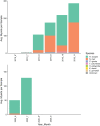Distribution and demographics of mysids (Crustacea: Mysida) as prey for gray whales (Eschrichtius robustus) in northwest Washington state
- PMID: 38239296
- PMCID: PMC10795525
- DOI: 10.7717/peerj.16587
Distribution and demographics of mysids (Crustacea: Mysida) as prey for gray whales (Eschrichtius robustus) in northwest Washington state
Abstract
Background: The movement and distribution of gray whales (Eschrichtius robustus) during the feeding season is likely dependent on the quality of foraging opportunities and the distribution of prey species. These dynamics are especially important to understand for the Pacific Coast Feeding Group (PCFG) of gray whales which spend the feeding season along the coast from northern California, USA through northern British Columbia, Canada. In Washington state, no previous work has been done to describe available gray whale prey. The main goal of this research was to initiate studies on an important gray whale prey item in northwest Washington, mysid shrimp (Mysida), by establishing a baseline understanding of mysid swarm demographics in the area and investigating patterns in gray whale and mysid presence.
Methods: Prey samples were collected during June through November 2019 and June through September 2020 using a vertically-towed plankton net at seven sites in the Strait of Juan de Fuca and seven sites in the Pacific Ocean in areas where gray whales were known to feed. Mysids collected in the samples were counted and the sex, length, species, maturity, and gravidity were documented. Patterns in gray whale and mysid co-occurrence were explored through data visualization.
Results: Seven species of mysids were observed in the survey area. In 2019, the number of mysids per tow increased steadily through the season, the most abundant species of mysids were Holmesimysis sculpta and Neomysis rayii, and sampled mysids averaged 4.7 mm in length. In 2020, mysids were abundant in tow samples in June and July but were not abundant in the remaining months of the sampling season. The average length of mysids in 2020 was 13.3 mm, and a large portion were sexually mature males and brooded females identified as H. sculpta. Throughout the survey area, the majority of whale sightings occurred later in the season in 2019 and earlier in the season in 2020, coinciding with the trends of sampled mysids.
Discussion: This study provides the first description of mysid swarm composition and temporal variation in northwest Washington. Tows were dominated by a similar assemblage of mysid species as what is observed in other areas of the PCFG range. The differences in sampled mysid assemblages between years, and the presence of whales in the survey area in times and at sites where samples with high mysid counts were collected, suggest evidence for interesting predator-prey dynamics that warrant further investigation.
Keywords: Eschrichtius robustus; Foraging ecology; Mysida; Pacific gray whale; Predator-prey dynamics.
© 2024 Allyn et al.
Conflict of interest statement
The authors are all employees of the Makah Fisheries Management department of the Makah Tribe.
Figures





Similar articles
-
Gray whale (Eschrichtius robustus) post-mortem findings from December 2018 through 2021 during the Unusual Mortality Event in the Eastern North Pacific.PLoS One. 2024 Mar 27;19(3):e0295861. doi: 10.1371/journal.pone.0295861. eCollection 2024. PLoS One. 2024. PMID: 38536874 Free PMC article.
-
Changes in gray whale phenology and distribution related to prey variability and ocean biophysics in the northern Bering and eastern Chukchi seas.PLoS One. 2022 Apr 7;17(4):e0265934. doi: 10.1371/journal.pone.0265934. eCollection 2022. PLoS One. 2022. PMID: 35390020 Free PMC article.
-
Benthic studies adjacent to Sakhalin Island, Russia, 2015 II: energy content of the zoobenthos in western gray whale feeding grounds.Environ Monit Assess. 2022 Oct 18;194(Suppl 1):742. doi: 10.1007/s10661-022-10020-z. Environ Monit Assess. 2022. PMID: 36255480 Free PMC article.
-
Is it 'boom times' for baleen whales in the Pacific Arctic region?Biol Lett. 2016 Sep;12(9):20160251. doi: 10.1098/rsbl.2016.0251. Biol Lett. 2016. PMID: 27601724 Free PMC article. Review.
-
Critical review of chronic toxicity testing approaches with the saltwater mysid (Americamysis bahia) used in pesticide registration.Environ Toxicol Chem. 2025 Apr 1;44(4):916-925. doi: 10.1093/etojnl/vgaf036. Environ Toxicol Chem. 2025. PMID: 39902585 Free PMC article. Review.
Cited by
-
Exploring indirect effects of a classic trophic cascade between urchins and kelp on zooplankton and whales.Sci Rep. 2024 Apr 29;14(1):9815. doi: 10.1038/s41598-024-59964-x. Sci Rep. 2024. PMID: 38684814 Free PMC article.
References
-
- Akmajian AM, Scordino JJ, Gearin PJ, Gosho M. Body condition of gray whales (Eschrichtius robustus) feeding on the Pacific Coast reflects local and basin-wide environmental drivers. Journal of Cetacean Research and Management. 2021;22(1):87–110. doi: 10.47536/jcrm.v22i1.223. - DOI
-
- Allyn L, Scordino J, Akmajian A. Plankton tow data from nearshore coastal Washington state 2019–2020. Mendeley Data. 2023 doi: 10.17632/xpsgkxdnwk.1. - DOI
-
- Augie B, Antonov A. gridExtra: miscellaneous functions for “grid” graphics. 2017. https://cran.r-project.org/web/packages/gridExtra/index.html https://cran.r-project.org/web/packages/gridExtra/index.html
-
- Burdi CE, Slater SB, Bippus TL, Jimenez JA. Mysid and amphipod length-weight relationships in the San Francisco Estuary. California State Interagency Ecological Program for the San Francisco Estuary Newsletter. 2021;40(1):15–25.
-
- Burnham RE. Reproductive strategies conferring species dominance in marine mysid (Peracarida, Mysida) species in coastal waters off Vancouver Island, BC. Crustaceana. 2015;88(12–14):1421–1438. doi: 10.1163/15685403-00003502. - DOI
MeSH terms
LinkOut - more resources
Full Text Sources

